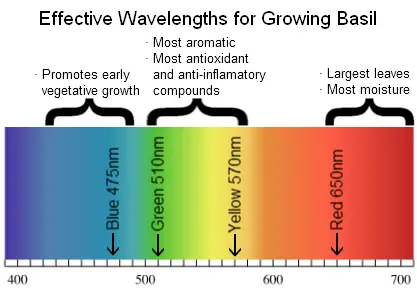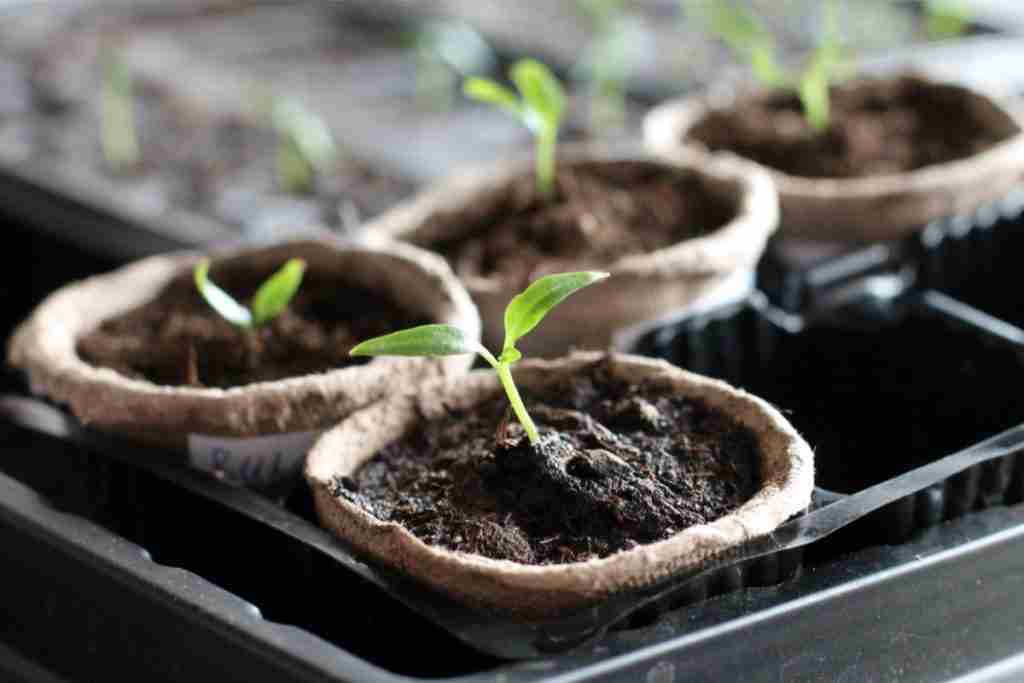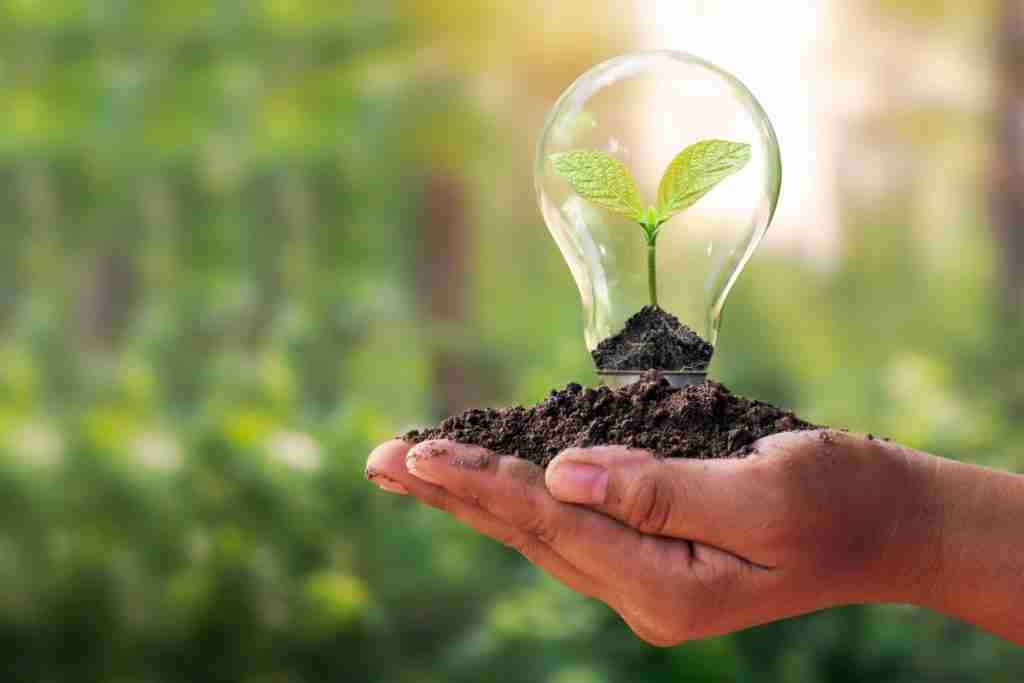
Growing plants indoors can be hard for beginners. Take-off can be tough for some of the most experienced gardeners out there. So, doing your homework before diving in is the best way to get the results you want the first time around, especially when it comes to lighting and each stage of plant growth.
The best color spectrum during the vegetative growth phase for plants is blue light. Blue light is responsible for successful germination and root support, ensuring your plant makes it past a seed.
Just because blue light is essential during the vegetative phase doesn’t mean it is the only important color on the light spectrum. For more information on how to light up your indoor garden to ensure the best outcome possible, read on!
Table of Contents
What Is the Color Spectrum for Plant Growth, and How Does it Work?
The color spectrum is the different colors of visible light that assist in the growth process of a plant. Each color has a unique effect on a plant. There is the natural light from the sun, which is vital to photosynthesis and photomorphogenesis.
Blue and red lights are known for being the most effective and beneficial lighting to assist in plant growth and development, but they are not the only essential colors out there. Yellows, greens, and even purples are important factors in successful growth.
But what exactly are these rays? The spectrum is wavelengths produced by a light source and absorbed by plants. Each color has its own wavelength, which affects the plant differently.
Red Light (630-660 nm)
Red light is one of the most required colors on the spectrum for optimal plant growth. The specific job of the wavelength of this color includes:
- Enables the proper growth of plant stems
- Aids in the expansion of plant leaves
- Regulates flowering
- Assists in dormancy periods
- Keeps seed germination on track
Blue Light (400-520 nm)
Blue light should be carefully mixed with other light in the color spectrum because too much can have damaging effects, such as stunted growth.
So, what does blue light do to help plants grow?
- Aids in water retention
- Supports strong root growth
- Assists in the direction of growth, leading the plant to grow towards its light source
- Affects chlorophyll content in the plant
- Determines the thickness of the plant’s leaves
Green Light (500-600 nm)
Green light is most helpful because of the distance it can travel to reach plants that require more lighting. It penetrates through the thicker high canopies in dense forests to support the leaves in the lower canopy.
Aside from that, green light doesn’t appear to have much impact on your plant’s health or growth and can cause more harm than good if they are over-exposed to it.
Far Red Light (720-740 nm)
Similar to green light, far red light also passes through higher vegetation to support growth to the canopy down low.
It also:
- Reduces the time needed for plants to flower
- Produces larger leaves compared to those without far red light exposure
Picture credit Metal Halide Grow Lights

What Color Spectrum Is Best for Vegetative Growth?
A full spectrum is ideal for almost all plant growth. here is a reason most plants require plenty of sunlight, not filtered sunlight. Each spectrum has its own purpose and will ensure you grow the strongest and most fruitful plants possible.
That said, blue light is the single most important color on the spectrum during the vegetative stage, with wavelengths between 400-500 nm being the most beneficial.
The vegetative state of plants starts right after seed germination takes place but before flowering occurs. During this period, most of the plant’s growth is completed, and it requires the most energy.
The vegetative period is, by far, the most important part of the plant’s life and requires optimal nutrients and essentials for the plant to thrive.
Blue light has a much shorter wavelength than red light. This means it doesn’t reach nearly as far. However, it holds much more energy, allowing the plant to absorb as much light as possible to assist in its growth.
Without the right amount of blue light, your plant will not have the strength it needs to secure a strong root system, and the plant will never take off, let alone reach its full potential.
Can You Have Too Much Blue Light?
Just because blue light is the most essential for vegetative growth doesn’t mean it can be given in excess amounts without any consequences.
Have you ever heard the phrase “too much of a good thing isn’t any good at all”? This goes for plant care just as much as anything else.
Too much blue light can stunt your plant’s growth. Remember when we mentioned the wavelengths are not as long? That means the plant won’t have the opportunity to reach as high.
What if You Only Use Red Light?
Red light is ideal for flowering plants after they have matured through the germination phase and are ready to bloom. Without blue light, though, your plant won’t make it to that part of life.
Adding blue light to your plants with the red light already in place will ensure your plants are strong and capable of producing large leaves, crops, and flower heads.
What Are the Best Lights for Vegetative Growth?

Now that we know all about spectrum colors and what they mean for your plant’s growth, especially during the vegetative state, we will discuss the best options for picking the best indoor grow lights for your plants.
You can purchase specific indoor grow lights for each phase of your plant’s life cycle, or you can pick a full-spectrum option that walks your plants through each phase as they get bigger and stronger.
What Are the Benefits of Using a Full-Spectrum Light for Vegetative Growth?
Although blue light is the most important light during the vegetative phase of plant growth, there are many benefits to using a full-spectrum light source rather than switching from light bulb to light bulb during each phase.
Here is a list of benefits associated with using a full-spectrum light bulb.
Reduces the Chance of Shock
While in the vegetative phase, your plant is already used to the current light source and growing according to the heat and light energy produced by the bulb.
If your plants are used to the blue light they receive from a single bulb, the leaves will not be prepared for a quick and sudden change which can then put your plant into a state of shock. This can stunt or even ruin the continuing growth phases.
If you use a full-spectrum light source, you can reduce the difference in energy and wavelengths received by the plant and reduce growth time, flower production time, and speed up production.
Benefits the Flowering Phase of Plant Growth
Blue light is imperative for the beginning stages of plant life, while red light benefits the flowering stages.
However, adding blue light to your plant before the flowering phase starts and leaving it on while the phase is in the process will help your plant grow stronger flowers and fruit, eliminating the chance of laggy stems and leaves.
Better Quality Plants
The less spacing between light changes equals denser flowers and higher quality plants.
Easier to Use
Instead of having to replace the bulbs or purchase a new light every time your plant enters a new phase, you can utilize a full-spectrum setup to ensure your plants are getting the proper energy and lighting they need without having to do any work.
Things to Consider When Choosing the Best Color Spectrum Lights for Your Vegetative Plant Growth
When you are ready to hit the market for a grow light for your plants before, during, and even after the vegetative phase, there are many things to consider to ensure your plants will get the best lighting possible.
Low Heat Output
While you want to ensure your plants get the best wavelengths and warmth possible during the vegetative phase of life, you also don’t want to risk scorching the leaves or risking dehydration.
Double check the heat output on the light source you choose and make sure it offers between 5,000 to 7,500 on the Kelvin scale.
Made With Quality Materials
A good light source doesn’t have to cost a fortune, and an expensive lighting source isn’t necessarily high quality. Finding a quality grow light that fits your budget is essential to successful plant growth.
Make sure you purchase a product from a reputable company that is well known and has great reviews. The last thing you want is to find out your plants never made it past germination because the light source you bought wasn’t up to par.
Plenty of Room for Growth
Because the vegetative period of a plant’s life is the point at which the plant grows the most, you must make sure the lighting source you purchase reaches each of your seedlings as evenly as possible.
Your light source, as a rule of thumb, should accommodate 32 watts of power per square foot for high-light plants and 11-18 watts per square foot for low-light plants.
Energy and Electricity Consumption

Since your plants will require upwards of 16 hours of light every day, you want to make sure you are using a product that considers this. Find a product that is energy efficient, and do not settle for anything that’s less than 300W.
Tip: No matter what type of light source you use, it is still vital that your plants receive plenty of water and nutrients to grow and thrive. Without these essentials, even the best bulbs out there can’t help your plant survive or reach their maximum potential.
Color Spectrum for Vegetative Growth FAQs
This is a lot of information stuffed inside one single article, and while we did our best to make it easy to follow, there may still be a few questions lingering.
Here are some common questions asked about the best color spectrum for vegetative growth with answers from professionals who know what they are doing.
How Long Should Your Grow Light Be on During the Vegetative Phase?
Your grow light should be left on for about 16-24 hours (depending on the plant you are growing). But it shouldn’t be shut off before 16 hours.
What Is the Best Lumination for a Plant during the Vegetative Phase?
A 7000-8000 lux is the ideal lumination for plants during the vegetative phase. It shouldn’t ever get any higher than this.
What Is the Best Light Bulb Color For Vegetative Growth?
If you are only concerned about the vegetative phase when growing your plants, the best color from the spectrum is blue.
Should I Worry about Green Light?
If you use a full-spectrum bulb, the green phase is included. However, if you are solely focused on the vegetative stage and plan on switching your bulbs throughout the plant’s growth cycles, you likely won’t notice any difference if you don’t add a green light bulb to the mix.
Should I Worry about Purple Light?
Depending on who you ask, purple light can greatly assist plant growth during the vegetative phase.
With that said, it might assist the blue light, but it can’t take the place of your blue light, and your plant can still thrive without it. When everything is said and done, plants with blue and red lighting should do just fine, even if no other light source is available.
Summing Things Up
If you want to grow the best plants possible from start to finish, a full-spectrum light source is your best choice. However, if the vegetative phase is your only concern, invest in a quality blue light LED bulb, and you will be amazed by the results you get.
